News Backgrounder
Taiwan’s airlines having a better pandemic than many airline peers
While 2021 started with a decline in passenger traffic, air cargo recorded a significant rise in demand. Positive economic data indicates air freight will be the money earner for Taiwan’s airlines in the months ahead. Tomasz Sniedziewski reports.
April 1st 2021
The first day of January 2021was not a good start to the year for Taiwan’s airlines. Read More » It marked the beginning of stricter border restrictions, introduced to contain the outbreak of new COVID-19 variants.
The toll of the rules soon became clear. By month end, China Airlines (CAL) had transported 33,355 passengers, a 97.4% year-on-year decline, and not a good omen for the flag carrier in the coming Lunar Year of the Ox.
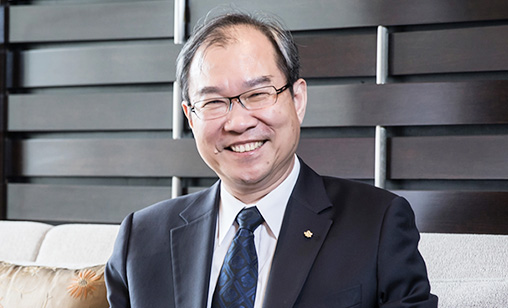 |
EVA Air carried 28,099 passengers in January, reporting an almost identical decline in its passenger traffic, at 97.6%, as CAL compared with a year earlier. EVA’s numbers also were 4% lower than the 32,852 customers it flew in December. Passenger revenue, although better than CAL, collapsed 91.9% year-on-year, to TW$870 million.
Luckily for the nation’s airlines, Taiwan eased restrictions on the entry of foreign visitors to the country and began allowing transit via Taoyuan International Airport from March 1. In fact, the policy change was a reversion to the rules of pre-January 1. Sobering for carriers was how quickly the restrictions could change to their detriment.
“The COVID-19 situation around the world is still somewhat serious. Travel restrictions and border closures mean most international passenger demand this year will come from essential travel such as business and overseas students. Travel for tourism remains to be seen,” spokesperson and vice president of China Airlines Corporate Communications Office, Marian Lu, told Orient Aviation last month.
EVA Air is optimistic about passenger traffic, based on the efficient handling of the pandemic by Taiwan’s government, including its easing of travel restrictions and the development of international air travel bubbles.
“Taiwan has effectively contained COVID-19 and our government is seeking opportunities to create air travel bubbles (ATB) with other countries. The Taiwan Central Epidemic Command Center has reopened Taiwan for transfer services on March 1, allowing passengers to connect through Taoyuan International Airport on flights continuing to their destinations. We expect more air travel in and out of our hub airport soon,” EVA Airways Public Relations Division’s Larry Lai said in a written reply to Orient Aviation.
In the final week of last month, CAL announced its operating results for the 2020 year to December 31. It reported consolidated operating revenue of TW$115.25 billion (US$4.04 billion), a consolidated operating profit of TW$2.184 billion and a consolidated net loss of TW$280 million.
Cargo was the star performer. Passenger revenue was 76.93% lower than the previous year, but air freight revenue soared by 87.06% over 2019. In the final three months of 2020, CAL hit a new record for single quarter cargo revenue, aided by the injection of 777F into a fleet already operating with 18 747F.
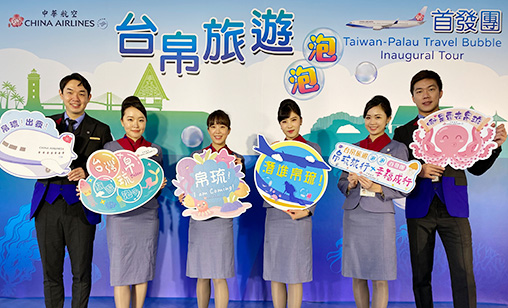 |
LOOKING FOR TRAVEL BUBBLES
Taiwan is enthusiastic about the opportunities air travel bubbles offer to increase passenger demand. When its first ATB, between Taiwan and Palau, was announced in March, share prices in travel companies soared to pre-pandemic levels, Taiwan’s Central News Agency reported.
Clearly the ATB between Taiwan and Palau, that has now come to fruition, will have a tiny impact on passengers carried by Taiwan’s airlines, especially as it only allows group travel with no individual free time and cartel-like fare structures.
It is a start. CAL is operating six flights a week between the two island states, EVA Air two flights a week and Palau’s Pacific Airways eight rotations weekly.
“China Airlines plans to actively compete for business opportunities from seasonal, themed or corporate charter flights. A multi-pronged marketing strategy that offers passengers a variety of different air travel experiences will help boost revenue. If border closures are lifted or quarantine times are shortened by the government, China Airlines will immediately adjust its passenger services to meet market demand,” its spokesperson said.
CARGO IS KING
Air freight has been a bright spot for Taiwanese aviation. The global recovery in the sector has been reported by the International Air Transport Association (IATA), the Association of Asia Pacific Airlines (AAPA) and in data from CLIVE Data Services and TAC Index.
“Air cargo has been resilient and, bit-by-bit, has clawed back the losses we saw only a few months ago. In April 2020, volumes were down 39%, but are back to pre-COVID levels. Who would have thought that possible inside 10 months? It’s a recovery airline passenger departments will be dreaming of”, said CLIVE Data Services managing director, Niall van de Wouw, in Air Cargo News.
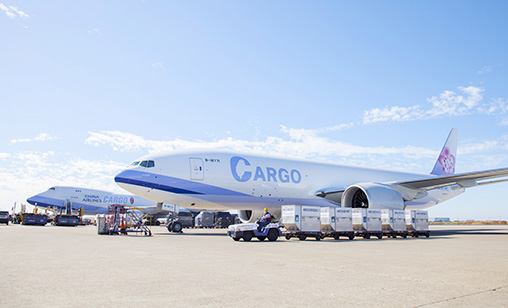 |
On top of the favorable global situation, Taiwan’s manufacturing activity increased in February for its eighth consecutive month. Its seasonally adjusted Purchasing Managers Index (PMI) is remaining above 60%. Strong demand for semiconductors made in Taiwan, and the switch by several forwarders from sea to air shipments translated into welcome business for both CAL and EVA.
In 2020, Taiwan’s GDP was 2.98%, placing it in a leading position among the world’s economies. Exports, boosted by the global demand for laptops, tablets, smartphones and other gadgets to support the work-from-home trend, reached US$345.28 billion, the highest value for a single year.
So far, 2021 has delivered even better news. Worldwide accelerated orders for computer chips put Taiwan’s economy on a trajectory for its fastest growth in seven years, the Directorate General of Budget, Accounting and Statistics announced in February.
It upgraded Taiwan’s GDP forecast for the year to 4.64% from a forecast 3.83%. In March, Chu Tzer-ming, the head of the Directorate, told parliament it was possible Taiwan’s GDP could reach 5% for the 12 months of 2021.
In the weeks leading to the mid-February Lunar New Year holiday, higher demand for air cargo allowed CAL and EVA to increase air freight rates.
On January 27, the market price on European air cargo flights ranged from TW$190 to TW$200 (US$6.71-US$7.07) per kg, translating into a 15%-25% price increase depending on the destination of the shipment. The price per kg for North American air shipments was TW$270 - TW$280, a rate rise range of 25% to 40%. Air freight rates from Taiwan to Hong Kong, Macau, and China started to inflate from the first weeks of the year from a base of TW$15-25 per kg, and nearly doubling by the end of January to TW$30-TW$40 per kg.
Overall, January exceeded Taiwan’s expectations for the sector. Cargo demand recorded by China Airlines - freight revenue tonne kilometers (FTK) - rose 43.5% for the month and cargo revenue improved 144% year-on-year, to TW$7.6 billion, the carrier said.
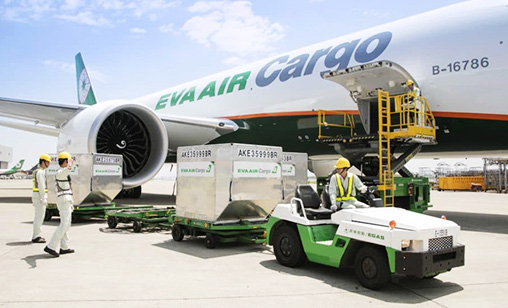 |
EVA Air’s January’s FTKs grew 34% year-on-year and cargo revenue was higher by 150%, at TW$1.9 billion.
The strong demand for cargo transport, together with the declining passenger capacity that limited passenger aircraft’s access to belly cargo space, created conditions for the first half of the year for freight rate increases. In this environment, the air freight prices to Europe could reach TW$250 and exceed TW$390 to North America, predict analysts quoted by media agency, UDN.
“China Airlines is actively monitoring cargo trends and sources. Progressive resumption or additional services on European routes are being planned. Technical stops are being adjusted to increase revenue. Freighter routes to the central U.S. or the east coast are being optimized or more hold capacity provided,” CAL’s Lu told Orient Aviation.
“Oceania routes are being assessed to determine the feasibility of regular freighter services to Australia and New Zealand. In Asia, there are plans to include Ningbo as a freighter destination.
“China Airlines will closely monitor market changes and COVID-19 developments to take advantage of high-value charters and optimize our freighter capacity to increase cargo volume and unit contribution.”
CAL and EVA are exploring the cold chain logistics market for opportunities offered by COVID-19 vaccine delivery, reports CNA. The airline has obtained its Center of Excellence for Independent Validations in Pharmaceutical Logistics (CEIV Pharma) when it passed IATA’s certification process in 2019. Only a limited number of airlines in Asia have received this accreditation so CAL hopes to dominate the market in the early stages of COVID-19 vaccine distribution alongside Singapore Airlines, Cathay Pacific Group and China Southern Airlines.
EVA heralds its experience in cold chain logistics and adds its representatives had briefed the government about its transportation capacity for the COVID-19 vaccine.
CAL cargo capacity has been boosted by the arrival of new 777F. Originally, the twin jets were to gradually replace the airline’s 747 freighters.
But Lu told Orient Aviation “China Airlines is continuing to optimize its fleet and has taken delivery of three all-new 777F. Twenty one freighters are therefore available this year, including the 18 existing 747F”, she said.
EVA has 777F and is being supported by all-cargo flights operated with passenger aircraft, - dubbed by some industry professionals as “preighters”. In recent months, cargo traveled on board all types of jets in EVA’s fleet.
“We are maximizing revenue by strategically using passenger flights for cargo only services to make up for lost travel demand and to minimize the gap. We will increase cargo capacity even more when we take delivery of three new 777 freighters from the final quarter of this year and the first three months of 2022,” EVA’s Lai said.
The hot cargo market has spread to Starlux Airlines, the ambitious carrier that started operations almost at the same time as the pandemic began. The carrier is carrying about 10 to 20 revenue passengers on board each of its flights but when cargo belly holds of its A321neo are fully loaded, the freight revenue basically supports variable costs, Starlux spokesman, Nie Guowei, told Taiwan’s ET Today.
In the CAL 2020 results statement, CAL chairman, Su-Chien Hsieh, said; “Opportunities offered by the transfer of sea freight should continue to generate steady demand in the air transport market in the first half of the year.
“This, along with steady growth in the stay-at-home economy, e-commerce and related communications equipment will see China Airlines optimize its freighter routes to the central U.S. and East Coast.
“Business will be expanded by adding services to increase cargo slot supply. The European market is showing signs of recovery. China Airlines is planning to add services to Europe, with stopovers in Delhi and Mumbai, to tap into India’s market potential.
“In Asia, new freighter destinations to Ningbo and Tianjin are in the planning stages to take advantage of market developments.”
STRICTER QUARANTINE REGIMES FOR CREW CREATES PROBLEMS
The unwelcome news of stricter quarantine rules for crew came into force in Taiwan last December after a pilot with a New Zealand passport and employed by EVA broke the island’s record of more than 200 days without any local COVID-19 infections. Despite the otherwise stellar epidemic safety record of the Taiwanese airline industry, public opinion was outraged not only by the behavior of the pilot. He took advantage of his position as a captain and violated strict company conduct by refusing to wear a mask on the flight from the U.S. to Taiwan, infecting two of his colleagues. The new rules extended quarantine to seven days, up from three days, for pilots and five days for flight attendants.
“The introduction of extended quarantine in January did affect our dispatching of flight crews and reduced capacity by more than 10%”, China Airlines Corporate Communications Office said.
“There is a good chance the regulations will be relaxed in the near future and this should alleviate our manpower shortage. Certain measures have been adopted for each flight dispatched by China Airlines based on national quarantine regulations and crew safety. These included adding crew for operating return flights on regional routes, cancellation of foreign stations with higher COVID-19 risk and the assignment of additional crew to operate return flights.”
EVA said the stricter rules “changed quarantine measures for flight crews and have had a big impact on EVA’s operations. Because all crew members are required to follow the stricter self-health management practices, it is challenging for us to adjust flight crew scheduling, rotation plans and flight plan dispatches”, the airline said.
“Aircraft crew is closely supervised and are managed to ensure they comply with home quarantine and self-health management guidelines. Work-life balance for crew members also is important to China Airlines. Crew quarantines are enforced without compromising on aviation safety,” Lu said.
FUTURE OUTLOOK
Solid demand for air freight, expanding manufacturing and export sectors and commitments from politicians to secure global supply chains for local industry ensure cargo will remain in the spotlight in Taiwan aviation in 2021.
“Cargo will continue to be the operational focus of China Airlines in the coming year. Congestion at European and North American seaports saw many urgent orders switch to air freight, CAL told Orient Aviation. In 2021, cargo will still benefit from a shortage of holds in the market. Demand for air transport [to transport] semiconductors, 5G, electric vehicles and medical supplies continues to remain high as well.
“China Airlines will make the most use of our 21 freighters along with the belly holds of passenger aircraft to dynamically adjust our capacity. We will also monitor market dynamics in order to adjust our cargo prices and compete for business opportunities.”
The recovery of the international passenger traffic depends on easing the border restrictions, something that Taiwan, so far very successful in limiting the spread of the coronavirus, is cautious about implementing, at least until it reaches its goal of vaccinating 60% - or15 million citizens - with a COVID-19 vaccine.
“IATA projects international travel will not recover to pre-COVID levels before 2024 at the earliest. Uncertainty caused by the pandemic could lead to more border restrictions and slow recovery for international travel demand. Rising oil prices have become a burden on airline operations. COVID-19 vaccines are helping the global economy recover from the pandemic but vaccination rates in Asia are behind those in North America and Europe. Asia may face a slower recovery,” said EVA’s Lai.
“The vaccine rollout means [more] travel bubbles may soon become a reality. China Airlines will work with the government and scheduled passenger routes when the market allows. At the same time, we will comply with the quarantine policies and regulations of each country, continue to practice protective measures aboard our aircraft, and enforce quarantine management for crew members,” CAL said.
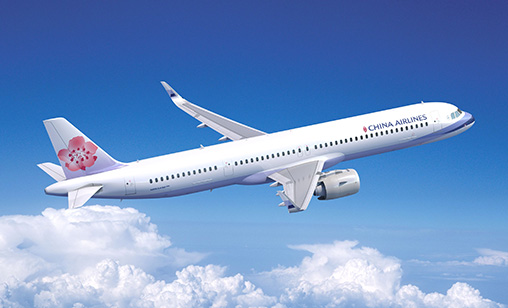 |
PREPARING FOR POST-PANDEMIC REALITY
CAL is busy with important fleet changes. Besides its new 777F, it will soon accept new A321neo to replace its narrow-body 737-800. “Deliveries of the A321neo passenger aircraft will commence this year as planned”, the CAL spokesperson said.
The last day of January marked the beginning of the phase out of Embraer’s E190 aircraft from the fleet of CAL subsidiary, Mandarin Airlines. In March, CAL farewelled its 747 fleet with the “747 Queen of the Skies Farewell Party” flown by CAL B-18215, which was delivered to CAL in April 2005.
Along with the fleet changes, CAL said “zero-contact travel had become a new air travel trend. In addition to online check-in and self-check-in of luggage, CAL is rolling out check-in kiosks with facial recognition in San Francisco, Hong Kong, New York, Taipei Songshan Airport and other airports around the world to provide more convenient and secure services”.
Carefully watched new entrant into Taiwanese skies, Starlux Airlines, is building brand identity with collaborations such as launches of premium brand cars, flights with alcohol tastings from a whisky producer, package tours - dubbed micro-travels – to Taiwan’s tourist spots and its own online shop.
Initially envisaged as a means to connect with the friends of the brand, the popularity of Starlux branded products has pushed sales on the site in some months to TW$10 million (US$354,000), said the Airline’s spokesperson, Nie Gouowei, in a recent national interview.
At the end of January, the Starlux brand expanded its digital footprint by launching a series of branded snacks and beverages in the Taiwanese distribution network of 7-Eleven Convenience stores.
In the meantime, Starlux is proceeding with its acquisition strategy which aims to have a fleet of 39 aircraft by 2024, putting it on par with CAL and EVA. Inauguration of flights to North America has been postponed until the end of 2022.
| Taiwan’s vaccine politics A recent edition of The Economist reported a trend: countries that curbed COVID-19 fast were being slow to vaccinate which could mean a return to normal air travel schedules was a distance prospect. Since the outbreak of the pandemic, Taiwan has recorded less than 1,000 cases of the coronavirus, of which most were imported. It has recorded 10 COVID-19 related deaths. The results have catapulted Taiwan into the global spotlight as one of the biggest success stories in controlling the virus outbreak. Ironically, the good news has meant the country is now lagging behind other nations in its vaccination program. It is not the result of lack of effort. It is the outcome of a specific geopolitical situation. Taiwan is excluded from the World Health Organization (WHO), which makes it difficult for it to acquire the vaccine, Taiwan’s leaders said. The first batch of vaccines has arrived in Taiwan with more planned in coming months, but to date the quota of the imported vaccines is too small to reach the vaccination targets set by the government. With negotiations continuing to acquire more vaccines on the international market, attention has turned to the development of local vaccines to fight the pandemic. At present they are proceeding through testing, but if they clear clinical trials phase III, they could be mass produced from July in sufficient quantities to vaccinate the entire population of Taiwan and also develop an export market. The topic of vaccinations in Taiwan is being politicized. As tensions between Beijing and Taipei have become more heated, Taiwan has announced Mainland- manufactured Chinese vaccines cannot be trusted because there is not sufficient data about their safety. Its leadership has ruled Taiwanese vaccinated with the Chinese vaccine will not be exempted from 14-day quarantine. In the long run, failing to recognize vaccines from both countries is expected to damage economically important cross strait traffic. |
Gena McKnight says:
June 20th 2021 11:08pm